by Margaret Sgarra, contemporary art curator
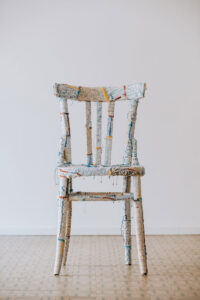
Cenzo Cocca, born in Ghilarza, has made embroidery his signature style, connecting threads and reflections. Trained at the Academy of Tailoring, he combines textiles with contemporary art, creating hybrid installations brimming with hidden meanings.
Your artistic research draws on embroidery and writing. Can you tell us why you chose these two visual modes in your work?
I think it was a very natural progression. In 2014 I decided to follow a dream: learning to sew. I started with a basic course and, the following year, in 2015, I chose to undertake an academic program that allowed me to delve deeper into the technique.
During my studies, I began experimenting with materials, paper in particular. From there, I began to create my first hand-embroidered works: portraits. It was on the back of these early works that the word first appeared, initially written in pen or pastel. The embroidered word subsequently made its appearance in 2019, when I inserted it into plans embroidered on paper. In 2021, a full-fledged research on the use of the word took shape, isolating it and transforming it into an embroidered text. I almost always use old doilies or handkerchiefs that I find in drawers, or that are often donated to me.
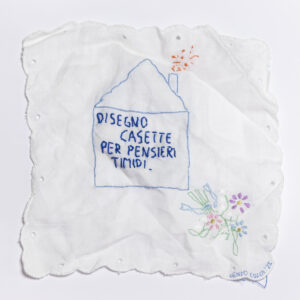
Your work often features short phrases. How are they chosen, and what meaning do they have for you?
It’s a way to give thoughts a shape, which I try to express through color. The idea is also to work on the back of the support, a fundamental part of the creative process for me. The back is, in fact, the heart of the work, it generates a new, incomprehensible language which becomes a new image. They are words that, therefore, transpire and, like threads, are deposited in the memory.
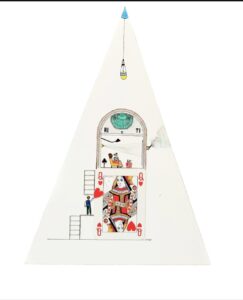
Another recurring element in your poetry is the French card game with its heart suits. What do they represent?
This is another research path that began during my studies, parallel to embroidery. During my sewing breaks, I began stripping the cards of their suits and imagining short, little stories. I began to tell them, playing with the cards themselves and the suits. This is how my first works were born, featuring two characters who are almost always present: Frankie and G. The two are the protagonists of short scenes that explore the theme of love in all its nuances.
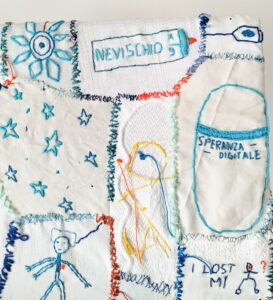
Delving deeper into the musical references, I noticed you mention Verdena, a band dear to me. This group uses language in a non-linear way, leading listeners to interpret their songs. Are there any common aspects between their music and your research?
I think the question you asked already contains the answer. In some works, in fact, I choose to work on the fragmentation of emotions, signs and words, creating a sort of collage. This results in works that don’t follow a precise line or a defined form. In this way, I try to leave to the viewer maximum freedom of interpretation, inviting them to construct their own meaning and work on their memory. Returning to Verdena, it is one of my favorite bands that I’ve been listening to since I was a child, I particularly love the evocative power of their lyrics. For me, music is a fundamental and necessary part of the creative process.
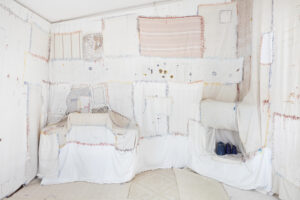
If you had to label your work, how would you define it? And what do you want to convey through it?
That’s a good question! I like to think of my work as a translation. A translation of emotions which pass through the body and transform, taking shape in the work. Each piece arises from a feeling that becomes a sign, a material, a color. I’d like to be able to excite, create contrasts and questions, inspire an inner movement in the viewer. I truly hope I can do that.
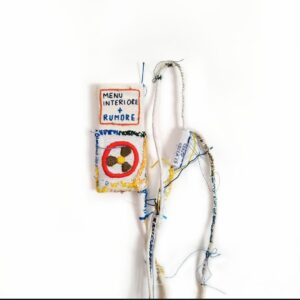
In Paesaggio digitale you address the issue of technology in relation to interpersonal relationships. What are your thoughts on this, and what do you want to convey through this work?
Since 2024, I have been pursuing an artistic research that explores the relationship between humans and technology, and its impact on everyday life. I recover technological objects that have influenced people’s growth and cover them with embroidered fabrics, erasing their original function, transforming them into tools of introspection. With this gesture, I “take possession” of them, just as they have influenced my life and, in some ways, took possession of mine. Through this slow and meditative process, I create a new dimension in which technology is completely transformed by a natural material, a symbol of human language and nature. This work, like others in the same research, is intended to be an invitation to pause, reflect and rediscover a deeper connection with oneself and the present.
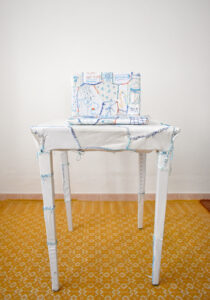 In your opinion, what is the purpose of art? And above all, what is the artist’s role in contemporary times?
In your opinion, what is the purpose of art? And above all, what is the artist’s role in contemporary times?
I have always believed that the role of the artist in contemporary times is that of an attentive observer, an interpreter, and a mediator of the times in which they live, capable of creating spaces for reflection that activate processes of inner inquiry. I believe it is important, and necessary, to stimulate through works, installations, or any other expressive form that can invite reflection on awareness of the present, in a world that is now moving at an increasingly rapid pace.